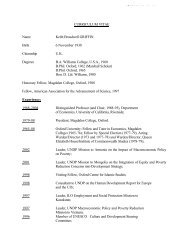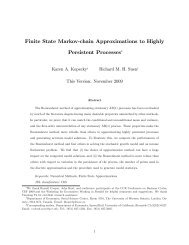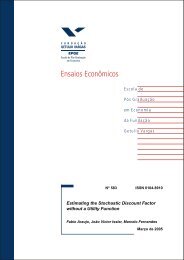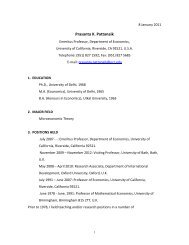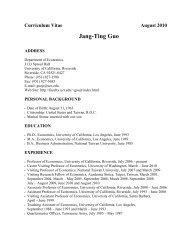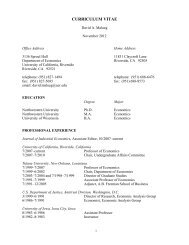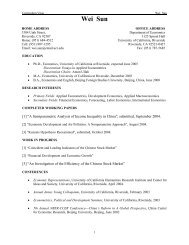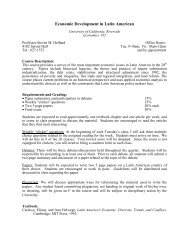Copula-based Multivariate GARCH Model with ... - Economics
Copula-based Multivariate GARCH Model with ... - Economics
Copula-based Multivariate GARCH Model with ... - Economics
Create successful ePaper yourself
Turn your PDF publications into a flip-book with our unique Google optimized e-Paper software.
4.1.1 Method 1<br />
The first method is <strong>based</strong> on Joe (1996), who derives a class of m-variate distributions <strong>with</strong> m(m −<br />
1)/2 dependence parameters from given univariate margins and bivariate copula margins.<br />
For m =3, given univariate margins (F 1 , F 2 , F 3 ), bivariate marginal copulas (F 12 , F 23 ),anda<br />
bivariate conditional copula (C 13|2 ), the trivariate joint distribution is<br />
F 123 (η 1 ,η 2 ,η 3 ; θ 12 ,θ 13 ,θ 23 )=<br />
Z y2<br />
−∞<br />
C 13|2<br />
¡<br />
F1|2 (η 1 |z 2 ; θ 12 ) ,F 3|2 (η 3 |z 2 ; θ 23 ) ¢ F 2 (dz 2 ) (15)<br />
where F 1|2 , F 3|2 are conditional CDF’s obtained from F 12 /F 2 , F 23 /F 2 , respectively. 6 By construction,<br />
(15) is a proper trivariate distribution <strong>with</strong> univariate margins F 1 , F 2 , F 3 , and bivariate<br />
margins F 12 , F 23 .The(1, 3) bivariate margin of F 123 can be obtained as<br />
F 13 (η 1 ,η 3 ; θ 12 ,θ 23 ,θ 13 )=F 123 (η 1 , ∞,η 3 ; θ 12 ,θ 23 ,θ 13 ) . (16)<br />
Note that F 13 depends on all three dependence parameters θ 12 ,θ 23 ,θ 13 . In general, it will not be<br />
thesameasC 13 (F 1 ,F 3 ; θ) for some θ. The different copula functions can be chosen for C 12 ,C 23 ,<br />
and C 13|2 .<br />
For m =4, we first obtain F 234 inthesamewaytogetF 123 in (15). Given the bivariate margin<br />
F 23 , we obtain the conditional CDFs F 1|23 = F 123 /F 23 and F 4|23 = F 234 /F 23 . Then following Joe<br />
(1996), the 4-variate distribution is<br />
=<br />
F 1234 (η 1 ,η 2 ,η 3 ,η 4 ; θ 12 , ··· ,θ 34 ) (17)<br />
Z η2<br />
Z η3<br />
−∞<br />
−∞<br />
C 14|23 (F 1|23 (η 1 |z 2 ,z 3 ; θ 12 ,θ 13 ,θ 23 ) ,F 4|23 (η 4 |z 2 ,z 3 ; θ 23 ,θ 24 ,θ 34 ))F 23 (dz 2 dz 3 ; θ 23 )<br />
where F 23 (dz 2 dz 3 ; θ 23 )=c 23 (F 2 (z 2 ) ,F 3 (z 3 );θ 23 ) · f 2 (z 2 ) · f 3 (z 3 ) dz 2 dz 3 by applying the chain<br />
rule to (14) for F 23 . This can be extended recursively and inductively to obtain higher dimensional<br />
distributions. See Joe (1996, p. 122).<br />
4.1.2 Method 2<br />
The second method is to use the multivariate Archimedean m-copulas, that can be obtained from<br />
the symmetricity and associativity properties of Archimedean copulas. See Joe (1997, p. 87),<br />
6 This equation (15) holds because f 123 (η 1 ,η 2 ,η 3 )=f 13|2 (η 1 ,η 3 |η 2 ) f 2 (η 2 ) implies<br />
η2<br />
F 123 (η 1 ,η 2 ,η 3 )= F 13|2 (η 1 ,η 3 |η 2 ) f 2(z 2)dz 2,<br />
−∞<br />
and F 13|2 (η 1 ,η 3 |η 2 )=C 13|2<br />
<br />
F1|2 ,F 3|2<br />
<br />
by Sklar theorem.<br />
11




